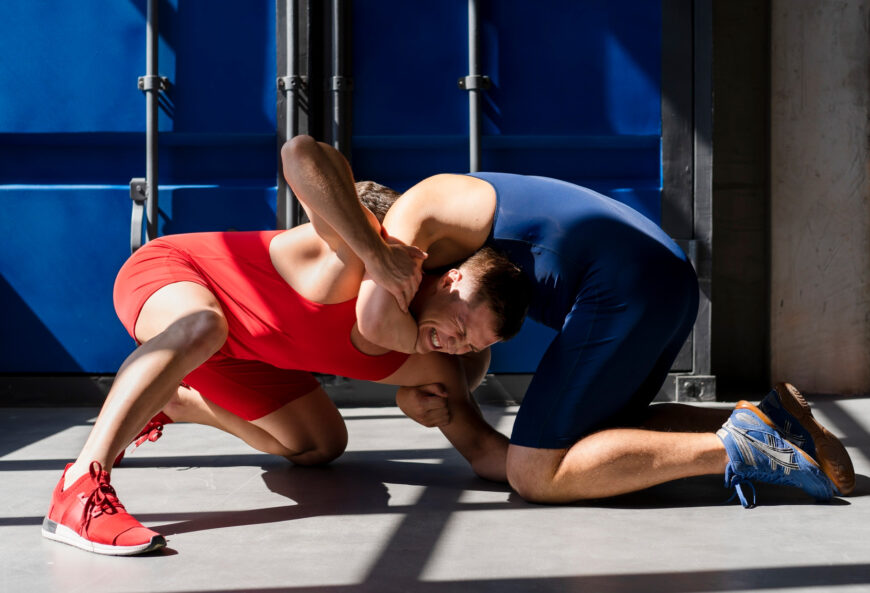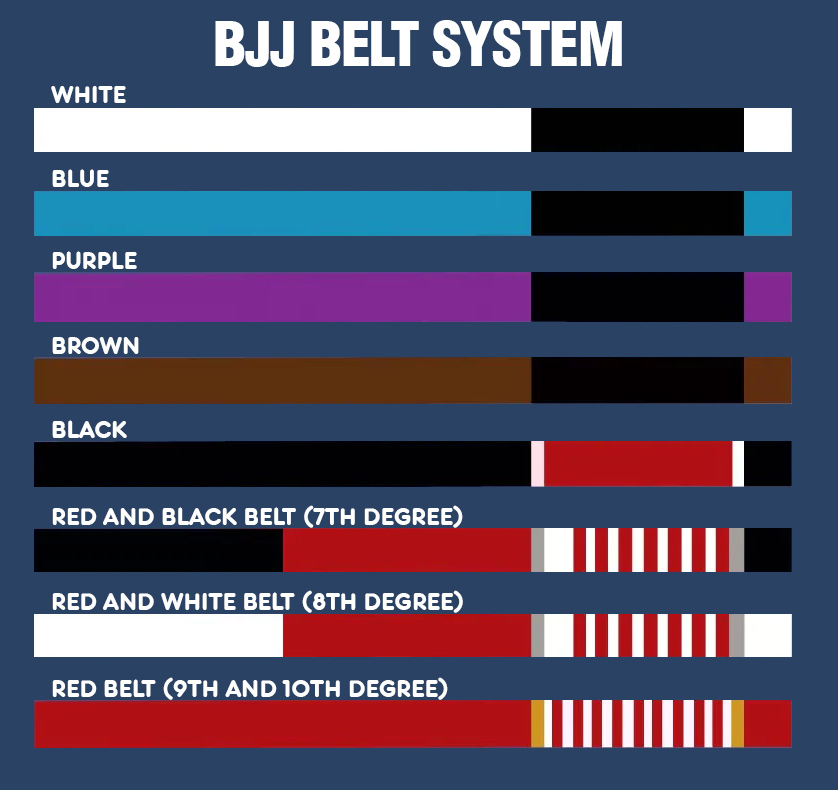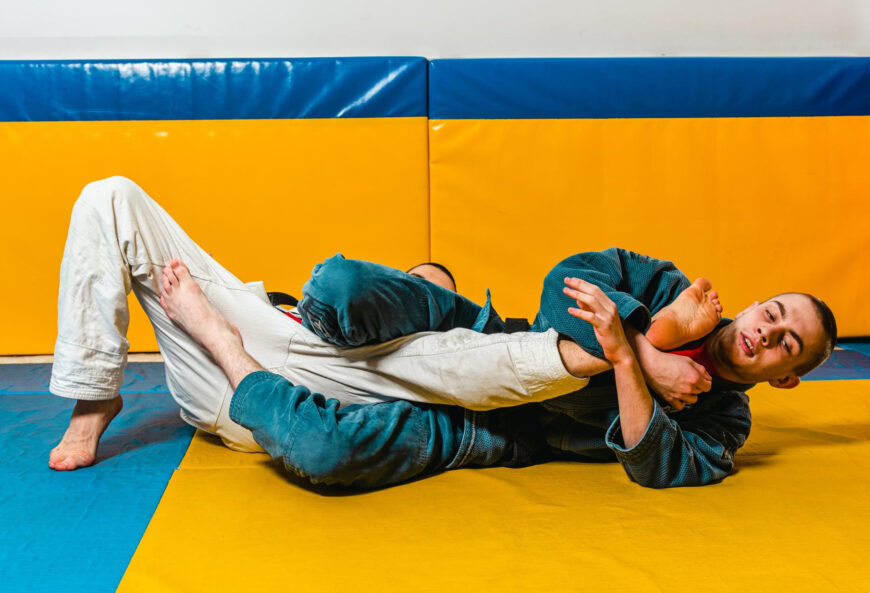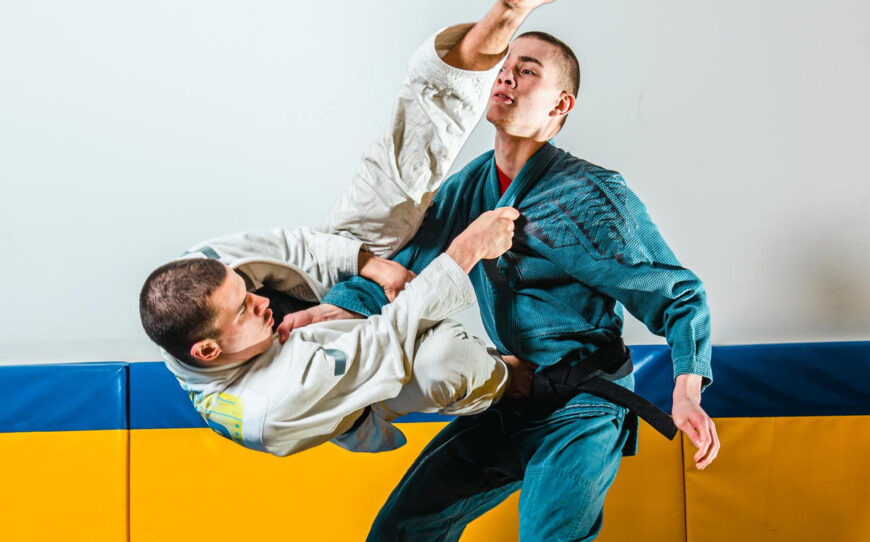Martial arts enthusiasts often find themselves debating the effectiveness of different fighting styles, and two favorites in these discussions are wrestling and Brazilian Jiu-Jitsu (BJJ).
Both combat sports have been practiced for centuries and boast rich histories that showcase their unique techniques and philosophies. While each discipline emphasizes grappling, they greatly differ in terms of strategy, scoring systems, clothing, gear, ranking systems, as well as their use in self-defense or MMA competitions.
In this blog post, we’ll delve deep into both wrestling and BJJ to analyze their key principles, rules, similarities & differences between them to help you better understand which one might suit your interests.
Key Takeaways
- Wrestling and Brazilian Jiu – Jitsu (BJJ) are popular grappling sports that both involve ground fighting and submission techniques, but they differ in philosophy, rules, and training methods.
- Wrestling emphasizes takedowns and dominance to overpower opponents, while BJJ focuses on technique, strategy, leverage and patience to apply submission holds.
- Both wrestling and BJJ can be effective for MMA competitions or self – defense situations. However, the decision on which one is better depends on individual preference and goals.
- Combining both wrestling and BJJ techniques can provide a well – rounded skill set in ground fighting techniques that give athletes an advantage over different opponents.
Origins and History of Wrestling

Wrestling, one of the oldest forms of combat, has a rich history that dates back approximately 15,000 to 20,000 years ago. Evidence of this ancient sport can be found in numerous cultures across the world, such as the cave drawings in France and religious texts from ancient Egypt.
Over time, various styles and techniques evolved within wrestling’s long-standing tradition. Royal families in France, Japan, and England during the Middle Ages often practiced this sport for entertainment and training purposes.
The modern era witnessed the emergence of distinct wrestling styles such as Greco-Roman, Freestyle Wrestling, Folk styles (including American folkstyle), Catch-as-Catch-Can or “Catch Wrestling,” and Submission wrestling – each with its unique ruleset and strategies.
Origins And History of Jiu-Jitsu (or BJJ)
Jiu-Jitsu, often referred to as the “gentle art,” can be traced back to ancient Japan, where it was practiced by Samurai warriors for centuries as a means of self-defense.
The Gracie brothers were first introduced to Judo by Mitsuyo Maeda, a prominent Japanese Judoka who traveled across continents sharing his expertise. The fusion of Maeda’s teachings with the adaptability and resourcefulness of the Gracie family resulted in BJJ becoming an effective fighting style that allows physically weaker fighters to overcome stronger opponents using leverage and technique.
Since its development in Brazil during the 1920s, BJJ has gained popularity around the world thanks to its prominence in mixed martial arts (MMA) events such as UFC competitions, where Royce Gracie highlighted its effectiveness against other martial arts styles.

Key Principles, Rules, And Ranking Systems
Both wrestling and BJJ have different principles, rules, and ranking systems that make them unique.
Wrestling Principles And Rules
Wrestling is a combative sport that requires physical strength, technique, and strategy. Here are some of the key principles and rules that govern this martial art:
- There are three primary styles of wrestling: Greco-Roman, Freestyle, and Folkstyle.
- Greco – Roman Wrestling focuses on upper body attacks, with no leg attacks allowed.
- Freestyle Wrestling allows for both upper and lower body attacks, providing more opportunities for takedowns and pins.
- Folkstyle Wrestling is the style practiced at the high school and college levels in the United States.
- Matches consist of two or three periods, depending on the level of competition.
- Points can be scored through takedowns, escapes, reversals, near falls, and penalty points awarded by the referee for rule violations or stalling tactics.
- Takedowns occur when one wrestler brings their opponent to the mat from a standing position while maintaining control.
- Escapes happen when a wrestler frees themselves from their opponent’s control while on the ground.
- Reversals occur when a wrestler in a defensive position gains control over their opponent by performing a counter-attack.
- Near falls take place when one wrestler has their opponent’s shoulders within four inches of the mat or at an angle less than 45 degrees for a specified amount of time
- The objective of wrestling is to pin your opponent’s shoulders to the mat simultaneously for at least two seconds (called a fall) or accumulate more points during regulation time.
By understanding these principles and rules of wrestling, participants can develop strategies and techniques suitable for MMA competitions and self-defense situations alike due to its intense focus on physical strength, hand-to-hand combat prowess, and relentless pace in grappling sports.
BJJ Principles And Rules
Brazilian Jiu-Jitsu, or BJJ, is a martial art and grappling sport that focuses on ground fighting and submission techniques. Here are its principles and rules:
- Objective: The objective of BJJ is to use leverage and technique to control the opponent and force them to submit through joint locks or chokes.
- Positions: BJJ has several dominant positions, including mount, back mount, guard, side control, knee on belly, and half guard.
- Submissions: BJJ emphasizes submissions over pins or points. Common submissions include armlocks, leg locks, chokes, and shoulder locks.
- Scoring: In competition BJJ matches, points are awarded for takedowns, sweeps (reversals from the bottom position), passing the guard (moving from one position to another while maintaining control), and certain submissions.
- Gi vs No-Gi: BJJ can be practiced in a traditional gi uniform or without the gi (no-gi). Each style has its own unique techniques and strategies.
- Belt System: BJJ has a ranking system based on colored belts ranging from white to black. Advancement is based on skill level and time spent training.
- Safety: Safety is emphasized in BJJ training with strict rules against striking or hitting an opponent during practice matches.
- Competition: There are various sports grappling tournaments such as the World BJJ Championship, WNO (Who’s Number One), Pan BJJ Championship among others where participants compete based on weight class and skill level.
In conclusion, mastering the principles of Brazilian Jiu-Jitsu requires consistent practice with emphasis on safety measures as well as knowledge of submissions techniques and scoring systems both in Gi & No-gi competitions.
Wrestling Ranking System
The ranking system in wrestling differs from BJJ, and here are some key points to note:
- Wrestling does not have a belt promotion system like BJJ.
- Athletes are ranked based on their performance in competitions.
- Rankings for high school level wrestlers are determined by state associations. while college-level rankings are determined by individual organizations like the NCAA or NWCA.(National Wrestling Coaches Association).
- International and Olympic – level rankings are determined by the United World Wrestling Federation.
- Rankings may be based on an athlete’s weight class or overall performance.
BJJ Ranking System
BJJ has a ranking system that includes five levels of colored belts, with the highest being the black belt. The ranking system is based on key principles such as respect, discipline, and humility. In order to progress through the ranks, students must attend classes regularly and demonstrate proficiency in techniques during sparring sessions. Competing in tournaments is also a requirement for promotion. The BJJ ranking system is associated with a rigorous training regimen that takes years of consistent practice and dedication to achieve the highest level. Students who earn their black belt are considered experts in the art of BJJ and have demonstrated an exceptional level of skill and experience.

Similarities and Differences Between Wrestling And Jiu-Jitsu
Both wrestling and Jiu-Jitsu involve grappling sports where the opponent needs to be taken down, held in a dominant position, or submitted.
Similarities
Both wrestling and Jiu-Jitsu (BJJ) involve ground fighting and grappling techniques that are essential in MMA and self-defense situations. They also share some similarities, including:
- Both sports require physical strength, endurance, and conditioning.
- Wrestlers and BJJ practitioners need to understand the importance of dominant positions, such as mount, back mount, guard pass, sweep, knee on belly, takedown/judo throw, near fall, and reversal.
- Both sports have a scoring system that rewards takedowns, pins or submissions.
- Wrestling and BJJ promote discipline through their ranking systems and promotion criteria – wrestlers progress based on their achievements at the school level, college level or international/Olympic; whereas BJJ uses colored belts to indicate rank promotions.
- Wrestling coaches often integrate Jiu-Jitsu techniques to supplement their programs for more efficient ground combat strategies; likewise with Jiu-Jitsu coaches who also incorporate wrestling moves.
MMA fighters can benefit from training in both sports as it allows them to enhance their grappling skills and take advantage of different techniques that may help in various situations during the fight. In addition to MMA fighters who engage with wrestling or BJJ styles when competing at different levels in tournaments or championships.
However, there are still notable differences between wrestling and BJJ which will be discussed further in the next section.
Differences
There are several key differences between wrestling and BJJ that make them unique in their own ways.
- Philosophy: Wrestling focuses on takedowns, control, and leverage to overpower opponents while BJJ emphasizes using technique, strategy, and patience to apply submission moves.
- Rules: Wrestling has a set of strict rules and regulations to follow whereas BJJ’s rules are more dynamic and flexible.
- Training Methods: Wrestling’s training sessions focus on building physical strength, endurance, agility, and conditioning while BJJ’s training sessions are aimed at perfecting techniques by drilling them repeatedly.
- Physical Demands: Wrestling requires intense physical exertion which can lead to injuries while BJJ is comparatively safer as it requires less physical strength and explosiveness.
- Techniques: Wrestling primarily concentrates on takedowns like double leg takedown or single-leg takedowns; meanwhile, BJJ focuses on grappling techniques such as submissions like armbar or rear-naked choke.
- Scoring System: Wrestlers gain points through takedowns and pins while in BJJ players score points from submitting the opponent.
- Ranking System: BJJ has a ranking system based on colored belts that signify different levels of expertise while wrestling does not have any such promotion system.
- Uniforms: Wrestlers wear spandex singlets, wrestling shoes, headgear, elbow/knee pads whereas Jiu-Jitsu fighters wear kimonos (gi), rashguards or shorts in no-gi competitions.
- Self Defense Techniques: Both disciplines emphasize self-defense moves with wrestling focusing more on stand-up striking skills whereas BJJ concentrates primarily on ground fighting techniques for self-defense scenarios.
Overall, both wrestling and BJJ has its own set of strengths and weaknesses making it important for individuals to identify their goals before choosing either discipline for self-defense or MMA purposes.
Pros and Cons of Wrestling And Jiu-Jitsu
Wrestling boasts superior takedowns and dominant positions, but can be limited in submission techniques; BJJ excels in ground combat and submissions, but requires strong conditioning for explosive attempts.
Pros of Wrestling
Wrestling is a highly effective fighting style that offers numerous benefits for self-defense and MMA fighters. Here are some pros of wrestling:
- Superior takedowns: Wrestling emphasizes takedowns, which can be incredibly useful in both self-defense situations and MMA fights.
- Dominant positions: Wrestlers learn how to control their opponent’s body, often from the top position, giving them a significant advantage in any fight.
- Explosive attempts: Wrestling requires explosive power and quick movements, which translates well into other martial arts or physical activities.
- Conditioning: As wrestlers need to be in excellent shape to perform at a high level, the training required for this sport improves overall cardio and conditioning levels.
- Strength development: The intense workouts involved in wrestling can lead to increased strength and agility.
- Complementary skills: Even if they don’t compete in wrestling tournaments, learning wrestling techniques can complement other martial arts like BJJ by providing additional takedown skills and an understanding of grappling concepts like scrambling and transitions.
- Valuable experience: Wrestlers have the opportunity to participate in high school or college level competition, where they gain invaluable experience competing against other skilled wrestlers while also building discipline and resilience.
Overall, incorporating wrestling into your martial arts training can offer many valuable benefits that enhance both your physical and mental abilities as a fighter.
Cons of Wrestling
Wrestling can be an effective fighting style, but it also has its disadvantages. For MMA and self-defense enthusiasts, here are some cons of wrestling:
- Wrestling relies heavily on physical strength: This means that wrestlers who are smaller or weaker may struggle to dominate their opponents.
- Wrestlers are vulnerable to submission techniques: Unlike BJJ fighters, wrestlers do not have many submission moves in their arsenal, which makes them more susceptible to being caught in a submission hold.
- Wrestling rules are rigid and less practical for self-defense: While wrestling is a sport with strict rules and regulations, these rules may not apply in real-life situations.
- Wrestlers may lack the stand-up techniques that are required in self-defense: Wrestling is primarily a ground-based style, which means that wrestlers may not have the necessary skills to defend themselves against standing attackers.
- Limited range of attacks: Wrestlers often rely on takedowns and body slams, leaving them vulnerable if these attacks fail.
While wrestling does have its downsides, it is still a valuable skill for any fighter to possess. However, if your primary goal is self-defense or you want to master technical fighting principles, BJJ may be a better option for you.
Pros of BJJ

Brazilian Jiu-Jitsu (BJJ) is a popular grappling martial art that has several benefits for those who practice it for MMA or self-defense. Here are some of the pros of BJJ:
- Effective against stronger opponents: BJJ techniques are designed to help smaller or weaker fighters defend themselves against heavier and stronger opponents by using leverage and submissions.
- Emphasis on control: BJJ emphasizes controlling your opponent’s movements, which can be helpful in neutralizing an attack or avoiding danger in a street fight.
- Good for cardio: BJJ provides a great workout for the cardiovascular system, which helps increase endurance, improve strength, and build muscle mass.
- Great for flexibility: Many of the techniques used in BJJ require flexibility, which means that regular training in this martial art can help improve flexibility as well as overall fitness levels.
- Promotes mental toughness: Consistently practicing BJJ requires discipline, focus and concentration; these qualities foster mental toughness over time and make one more adaptable to dealing with difficult situations.
- Teaches problem-solving skills: BJJ teaches practitioners how to think strategically and adapt their techniques when dealing with different types of opponents. It also instills a sense of confidence in those who practice it.
- Low impact sport: Unlike other combat sports that involve striking such as kickboxing or boxing, BJJ is a low-impact martial art that has less risk of injury associated with it.
Overall, BJJ is an effective grappling martial art with significant advantages in self-defense situations as well as in MMA competitions where it has been proven to be very successful. Regular practice under the guidance of qualified instructors can help one develop expertise at this sport while enjoying all its benefits mentioned above.
Cons of BJJ
Brazilian Jiu-Jitsu, like any other fighting style, has its drawbacks. Here are some cons to keep in mind:
- Over-reliance on ground fighting: BJJ is primarily a ground-based martial art, meaning that it heavily emphasizes grappling techniques and ground control. However, this can be a disadvantage when opponents have better stand-up or striking skills.
- Limited self-defense techniques: While BJJ has proven to be an effective self-defense tool in many situations, it’s not always practical outside of controlled settings such as the gym. For example, BJJ doesn’t teach students how to defend against multiple attackers or weapons.
- Risk of injury: As with any combat sport, there is always a chance of injury when practicing or competing in BJJ. Joint locks and chokes can lead to sprains or even broken bones if not executed properly.
- Inconsistent ranking systems: Unlike more traditional martial arts such as karate or judo, the ranking system in BJJ varies depending on the school or academy. This can make it difficult for students to compare their skill levels with others outside of their own gym.
- Gi dependency: A large portion of BJJ training involves the use of a gi (or traditional uniform), which can become a crutch for some fighters who struggle without it. This reliance on the gi can also limit creativity and experimentation in training and competition.
Despite these drawbacks, BJJ remains a popular and effective martial art for both self-defense and competitive fighting contexts. By being aware of these potential limitations, practitioners can better evaluate whether BJJ is the right fit for their needs and goals.
Wrestling and Jiu-Jitsu In Self-Defense and MMA
Wrestling and BJJ are both effective fighting styles in self-defense situations due to their ground positions, chokes, and joint locks.
Effectiveness In Self-Defense
In the realm of self-defense, both wrestling and jiu-jitsu can be highly effective, albeit in different ways. The table below outlines the effectiveness of wrestling and BJJ for self-defense purposes:
| Wrestling | Jiu-Jitsu (BJJ) |
|---|---|
| Strength and explosive power come in handy for self-defense, as they allow for quick and decisive actions. | BJJ techniques, particularly those involving submission holds and locks, can neutralize opponents without causing severe injury, making it a more humane option for self-defense. |
| Wrestling’s focus on takedowns and pins can help control an aggressive attacker, providing opportunities to escape or call for help. | BJJ’s groundwork and submission techniques are effective against larger and stronger attackers, as they rely on leverage rather than brute strength. |
| Wrestling requires a high level of physical fitness, which can be an advantage when facing multiple threats or when self-defense situations lead to extended physical confrontations. | BJJ teaches patience and calmness under pressure, which can be valuable in self-defense scenarios where remaining composed can make a significant difference. |
It is essential to note that the effectiveness of wrestling and jiu-jitsu in self-defense situations depends on the individual’s skill, experience, and ability to apply the techniques under stress.
Effectiveness In MMA
Wrestling and Jiu-Jitsu are both integral components of Mixed Martial Arts (MMA) and have proven their effectiveness in numerous high-profile bouts. The following table highlights the major aspects and effectiveness of each discipline in MMA events.
| Aspect | Wrestling | Jiu-Jitsu (BJJ) |
|---|---|---|
| Take-downs and Control | Highly effective for executing take-downs and maintaining top position, allowing for ground and pound and control of the fight. | Take-down techniques can be more subtle, relying on leverage and timing, but can still be effective in securing dominant positions. |
| Submissions | While wrestling has some submissions, it is not the primary focus of the discipline. | Extremely effective in securing various chokes and joint locks, resulting in a high submission rate in MMA. |
| Defense | Strong wrestling base aids in defending against take-downs and maintaining balance, making it harder for opponents to secure submissions. | Effective in escaping and reversing difficult positions and avoiding damage through the use of guards and sweeps. |
| Transitioning | Smooth and powerful transitions between positions, making it hard for opponents to counter or escape. | Fluid movement between positions, using leverage to create openings for submissions and advances. |
| Cardio and Stamina | Wrestling demands high energy output, potentially causing fatigue if not managed properly. | BJJ fighters tend to focus on efficiency in movement and conservation of energy, often resulting in better stamina management. |
| Overall Effectiveness | Wrestling has proven to be highly effective in MMA due to its control and ability to dictate where the fight takes place. | BJJ has also shown effectiveness in MMA, particularly in securing submissions and the ability to remain dangerous even from disadvantageous positions. |
Both wrestling and Jiu-Jitsu have their strengths and weaknesses, and fighters who can effectively combine these disciplines are often the most successful in MMA competition.
Combining Wrestling and BJJ Techniques
Combining wrestling and BJJ techniques can elevate a fighter’s skills in both martial arts. Wrestlers can learn from BJJ techniques to improve their ground game, while BJJ fighters can benefit from learning wrestling techniques to improve their takedowns and control on the ground.
For example, wrestlers typically excel at explosive takedowns; adding chokeholds and joint locks learned through studying BJJ makes them more well-rounded combatants.Transversely, by mixing wrestling moves with jiu-jitsu moves like ankle locks or triangle chokes, fighters become harder to predict which helps keep opponents guessing while also making it easier for the wrestler/jiu-jitsu fighter hybrid to launch an offensive attack.
By combining Wrestling and Jiu-Jitsu (BJJ), fighters will gain not just physical attributes but strategic advantages as well. A fighter who knows how wrestlers take down their opponents might best use this knowledge when up against someone who is bigger or stronger or even someone who is skilled in that area but familiarizing themselves with areas outside their discipline gives more chances for victory.
FAQs
What is the difference between wrestling and Jiu-Jitsu (BJJ)?
Wrestling focuses on takedowns, grappling, and controlling your opponent using strength and technique. Jiu-Jitsu (BJJ) also involves grappling and control techniques but emphasizes submission holds that force an opponent to tap out or give up.
Which one is better for self-defense: wrestling or Jiu-Jitsu (BJJ)?
Both wrestling and Jiu-Jitsu (BJJ) can be effective for self-defense depending upon the situation. Wrestling may be more useful in situations where quick takedowns are necessary while BJJ provides a greater variety of submission moves that can help neutralize attackers without causing harm.
Can someone cross-train in both wrestling and Jiu-Jitsu?
Yes, cross-training in both sports can improve overall skills as they complement each other well with similar ground work techniques.
Is either sport safer than the other?
Safety from injury depends greatly on individual athletes’ level of skill, proper training & supervision . While injuries do happen in contact-based sports such as these ones there isn’t any empirical evidence suggesting one over the other being inherently more dangerous since it varies greatly from user-to-user based upon their technique/form & familiarity with different moves/holds/stretching routines among others things..
Conclusion: Which Is Better – Wrestling Or Jiu-Jitsu?
In conclusion, the decision on whether wrestling or jiu-jitsu is better ultimately depends on individual preference and goals. While both martial arts have their own unique strengths and weaknesses, they also share similarities in terms of principles and techniques used.
Wrestling emphasizes aggressive moves to dominate opponents, while BJJ prioritizes submission holds to take down an opponent with ease. Both sports can be effective for self-defense and MMA competitions.
Combining wrestling and BJJ can lead to a well-rounded skill set in ground fighting techniques.









